Goal For This Post
Hello everyone! Today I’m back and I’m going to walkthrough how I create and spin up my Kubernetes environment at home. This is a great way to get hands on with various different technologies and allows you to start deploying applications on a local Kubernetes Environment. Because Kubernetes can be complicated and tedious to deploy (especially in enterprise environments) it would be best to automate the process of deploying and installing Kubernetes automatically through the use of an Infrastructure as Code approach. My personal preference for this would be using Ansible. With all of that in mind, the goal of this post is to walk you through the process of deploying Kubernetes on local bare-metal using an automated ansible deployment!
Prepping the Environment
To begin, it’s important to understand that you don’t necessarily need to use bare-metal for this setup. If you have a beefy-enough server and can run a couple of virtual machines, that would also suffice. Or you could even use a cloud platform like AWS/GCP and deploy EC2 instances! In this setup however I’m going to be deploying Kubernetes on 5 nodes, having 1 Master and 4 worker nodes. It’s actually advisable to deploy Kubernetes while having an odd number of Worker nodes, but I’m not going to be running any heavy workload on them and want the extra resource efficiency gained by the extra worker node.
All of my nodes will be installed using a RedHat 9.5 image, and I will have a separate laptop that I will designate as my ansible-controller. My laptop will ultimately be where I deploy the cluster using Kubernetes and ultimately manage it. My laptop is running a flavor of Rocky Linux.
Assuming you have Rhel9 installed on all of your nodes, lets first start by installing ansible on your controller:
1
dnf install -y ansible
Then lets create a directory to work out of:
1
mkdir -pv /home/user/Kube_Ansible
Now let’s create a hosts file. This file is what ansible uses to know which hosts to connect to and ultimately make changes. Because I already installed an OS on my hosts, I also configured the hostnames and DNS; therefore I update my DNS server to reflect their hostnames. All that to say, I configured my hosts file to use DNS records, however if you didn’t want to setup DNS you could specify each IP. My hosts file is also grouped by what host I want to be my Master/Worker and is denoted through [ ] square brackets.
# /etc/ansible/hosts
[Manager]
mainrhel
[Workers]
rhel9bee
gmrhel
acerhel
mainrhelb
An optional step is to copy this directory into the following directory (or just edit that file directly) so that you won’t have to specify a hosts file when running ansible.
1
mv hosts /etc/ansible/hosts
We will want to use public/private key infrastructure when authenticating through ansible, therefore I will create and push my laptops host root ssh keys using the following command:
1
ssh-keygen
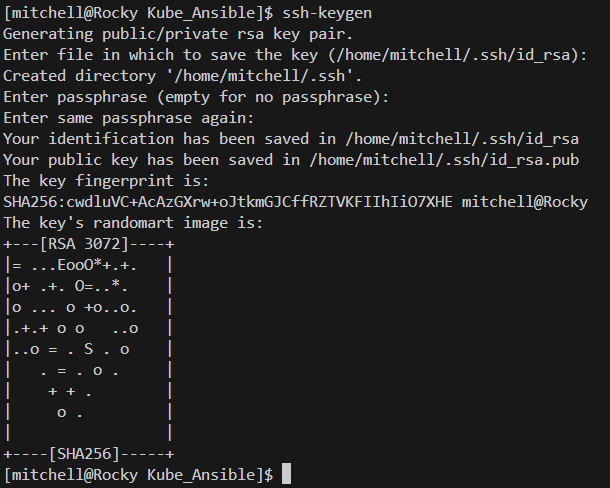
There are 2 more things we will need to do before running our first ansible script; first we will need to make sure that host_key_checking is disable in the main ansible configuration file. If this setting is not set; then when we try to ssh into our nodes the first time we will get an error asking if we are sure that the ssh host is valid and to type yes to continue the connection.
1
export ANSIBLE_HOST_KEY_CHECKING=False
Second, we will need to install some ansible packages. Ansible packages allow Ansible (and really python) more options when specifying commands. We will be installing the posix collection which has a bunch of built-ins for managing Linux systems and the community.general collection to manage modules inside our Rhel9 systems.
1
2
ansible-galaxy collection install ansible.posix
ansible-galaxy collection install community.general
Now let’s create our first playbook, this will seem a little complicated if you don’t have much experience writing playbooks or don’t work with yaml files a lot, the important thing to understand is that it will copy the public key in this directory and put it in the appropriate directory on all the nodes so that we can ssh into the nodes in the future.
1
2
3
4
5
6
7
8
9
10
11
12
13
14
15
16
17
18
19
20
---
# push_pubkey.yaml
- name: Deploy my root public key to all nodes for passwordless SSH
hosts: all
become: true
become_method: sudo
tasks:
- name: Ensure the .ssh directory exists
ansible.builtin.file:
path: /root/.ssh
state: directory
mode: 0700
- name: Deploy my root public key
ansible.posix.authorized_key:
user: root
key: ""
state: present
You will want to run this playbook with the following command; note that you will be prompted to enter the root password for all of these hosts, it would be a good idea after you push the keys to go back and disable username/password ssh login for root (maybe even through ansible 👀). Also note that your output will be slightly different than mine, as I already successfully pushed my keys, but the end result should stay the same.
1
ansible-playbook --ask-pass push_pubkey.yaml
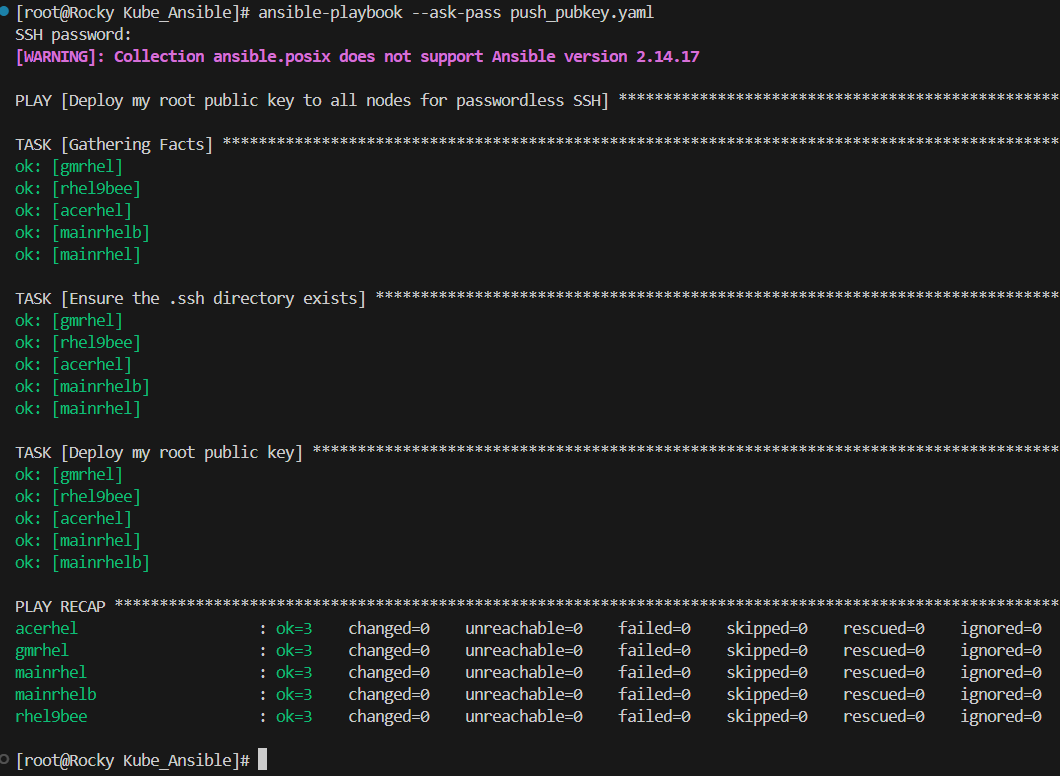
Opening the firewall and other networking
Networking can be a pretty daunting concept to understand and unfortunately that doesn’t stop with Kubernetes. Fortunately, now that we understand an can run ansible playbooks there is another playbook that we can run that will open all of the necessary ports in order for the various Kubernetes APIs to communicate with one another. You’ll notice that these are seperated by the role of the node (Manager v. Worker). Additionally at the bottom of this playbook I also enabled the ability to forward traffic. This is essential to K8s working and thus is required and the reason it’s incorporated in this playbook:
1
ansible-playbook firewall.yaml
1
2
3
4
5
6
7
8
9
10
11
12
13
14
15
16
17
18
19
20
21
22
23
24
25
26
27
28
29
30
31
32
33
34
35
36
37
38
39
40
41
42
43
44
45
46
47
48
49
50
51
52
53
54
55
56
57
58
59
60
---
- name: Open Up Required Ports
hosts: Manager
tasks:
- name: Open ports for Master Node
vars:
ports_to_open:
- 179/tcp
- 5473/tcp
- 6443/tcp
- 2379-2380/tcp
- 10250/tcp
- 10259/tcp
- 10257/tcp
ansible.posix.firewalld:
port: ""
permanent: true
state: enabled
immediate: yes
loop: ""
- name: Open Ports for Worker Nodes
hosts: Workers
tasks:
- name: Open Ports for Worker Nodes
vars:
worker_ports:
- 179/tcp
- 5473/tcp
- 10250/tcp
- 10256/tcp
- 30000-32767/tcp
ansible.posix.firewalld:
port: ""
permanent: true
state: enabled
immediate: yes
loop: ""
- name: Enable port forwarding
hosts: all
tasks:
- name: Load br_netfilter kernel module
modprobe:
name: br_netfilter
state: present
- name: Enable bridge netfilter for iptables
sysctl:
name: net.bridge.bridge-nf-call-iptables
value: 1
state: present
reload: yes
- name: Enable IPv4 forwarding
sysctl:
name: net.ipv4.ip_forward
value: 1
state: present
reload: yes
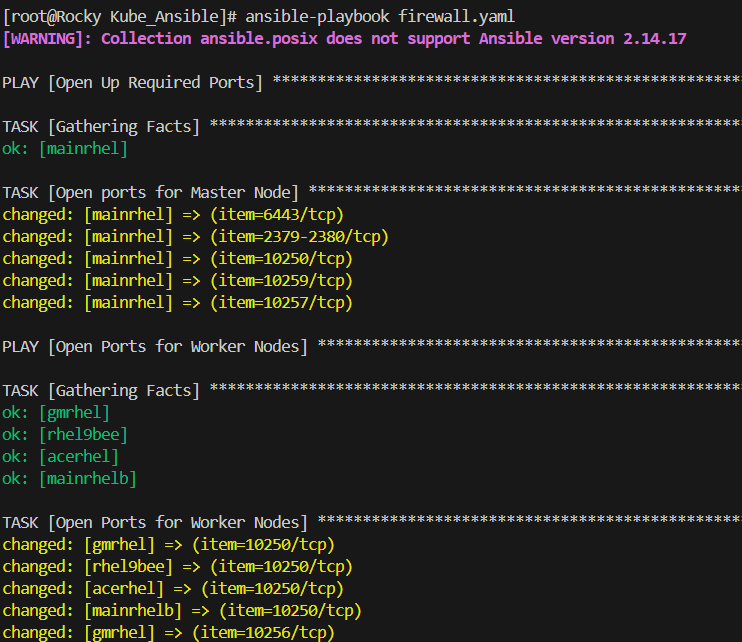
We are almost ready to begin, but before we start the automated deployment we are going to make sure that all of our systems are registered and updated. If you don’t already you can sign up for a RedHat developer license in order to deploy these hosts for free. Make sure you change the values for your username/password
1
ansible-playbook dnf_install.yaml
1
2
3
4
5
6
7
8
9
10
11
12
13
14
15
16
17
---
# Update Username and Password
- name: Ensure system is registerd
hosts: all
tasks:
- name: register systems
community.general.redhat_subscription:
username: "username"
password: "password"
- name: RHEL DNF Install Updates
hosts: all
tasks:
- name: update systems
ansible.builtin.dnf:
name: "*"
state: latest
Understanding the Deployment
Finally, the moment of truth! We are ready to deploy and if you’re ready to go then please feel free to scroll down and launch; otherwise I’m going to spend a couple of paragraphs talking about what the script is doing in order for this deployment to be successful and some of the pitfalls of running k8s on Rhel.
Disabling Swap
The first part of the script aims to disable swap on all nodes in the cluster. With swap enable, Kubernetes can’t easily determine performance and degredation of resources on each worker node so it is recommended to disable swap. This is a relatively easy fix, and with 2 tasks of turning the swap off first and then making the change persistent by editing /etc/fstab. 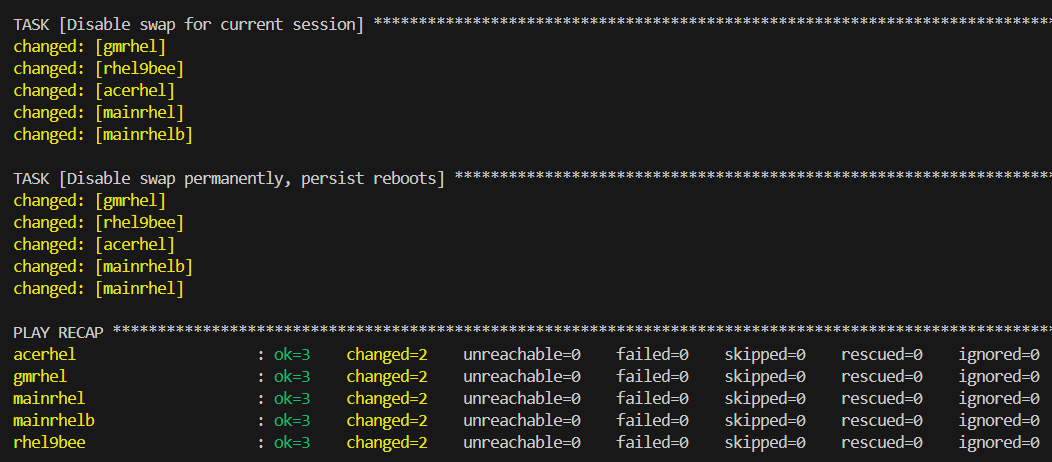
Disabling SElinux
Now this is where the deployment gets a little scary. If you’re not aware, SElinux is a security architecture for Linux systems that allow control over who/what has access to the systems. It’s also notorious for causing issues when rolling out new software and this is definitely the case with K8s.Kubernetes recommends disabling SElinux as there is a lot of processes and kernel calls that various processes/containers/services that are needed to successfully deploy. With that in mind, disabling SElinux could expose your system to more risk, so please proceed at your own caution.
1
2
3
4
5
6
7
8
9
10
11
12
13
14
- name: Disable SElinux and Add Kube Repo
hosts: all
tasks:
- name: Set SELinux to permissive mode temporarily
command: setenforce 0
register: result2
changed_when:
- result2.rc == 0
- name: Disable SELinux permanently
command: sed -i 's/^SELINUX=enforcing$/SELINUX=permissive/' /etc/selinux/config
register: result3
changed_when:
- result3.rc == 0
Installing a Container Runtime
Contrary to what you may already believe, Kubernetes (and its associated APIs) aren’t actually the service deploying containers, that is handled by the container runtime. Kubernetes also doesn’t ship with a standard container runtime and instead posts guidelines that vendors need to meet in order to be complient. RedHat has a kubernetes service called Openshift that uses the CRI-O runtime, however that runtime is only available if you have the appropriate registries (through licensing). Hence a workaround is required; and thus I decided to download and implement containerd as the container runtime in this k8s deployment. This section of the ansible playbook involves downloading the right binaries and installing them on all systems. This also includes the CNI binaries that are necessary for Kubernetes services. 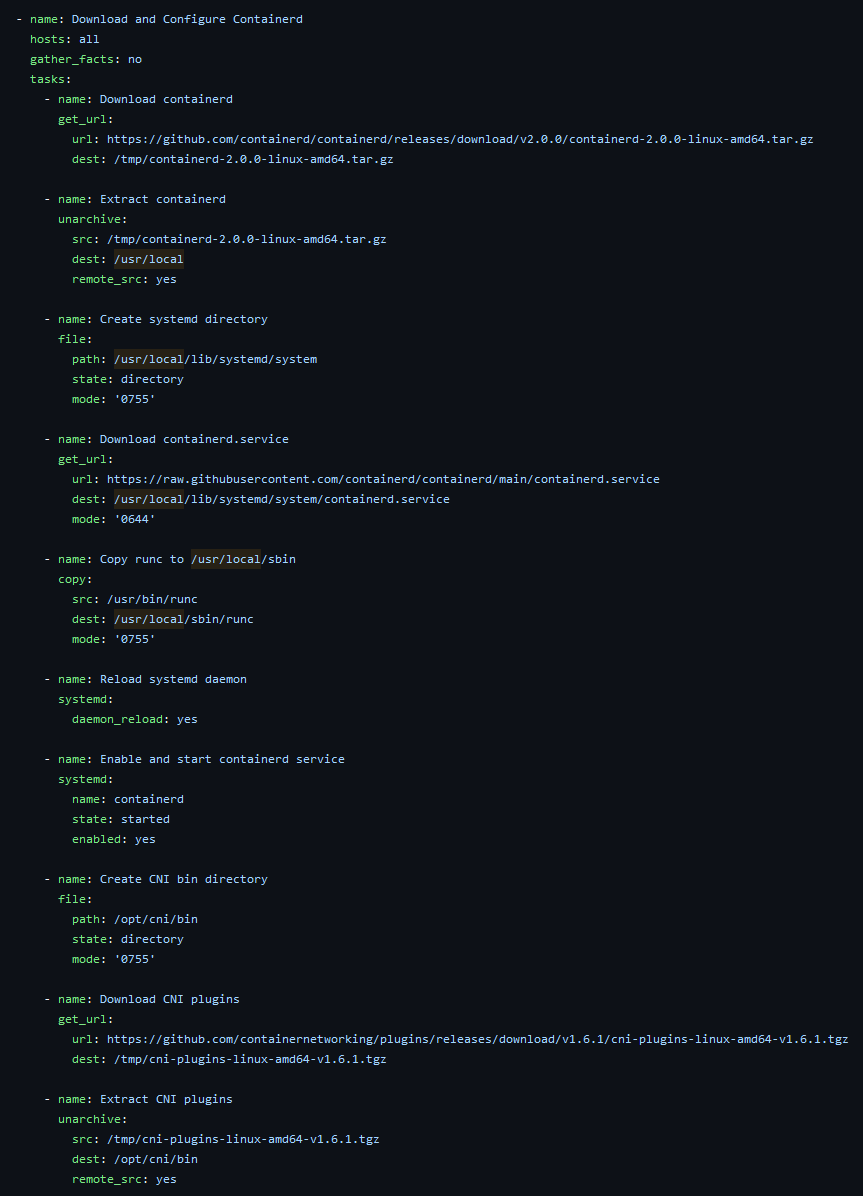
Kubelet, Kubeadm, Kubectl
This is where the real meat and patatoes of the playbook come into play. The importtant thing to note about this section of the playbook is that all the dependenies will be manually installed like conntrack on all the nodes. All of these services will be installed but they won’t be initalized yet. That will ultimately be the job of Kubeadm and configured on the manager node. There is one variable that you may want to change, which is the pod_cidr. In this configuration my private home network is in the 192.168.1.0/24 subnet, Kubernetes needs it’s own dedicated pod network which is why I specified in the kubeadm deployment the 10.0.0.0/16, so if your home network is in the 10.0.0.0/16 subnet you will want to change it. It’s also important to know that this script is written in a way in which you can run this script multiple times. Once you deploy kubeadm you can’t re-run the configuration, however this script is written that it will skip that process if you want to change something and re-run it.
Installing a CNI
Once Kubadm is installed, we have to configure the networking. Thankfully we can have software called a container network interface (CNI) handle the routing and switching inside the cluster. Again the script manually installs the CNI, configures it based off our current configuration and apply it. The CNI will now show up as a pod running inside the cluster. The important thing to note is if you changed your pod_cidr network from earlier you will also want to change it here too. 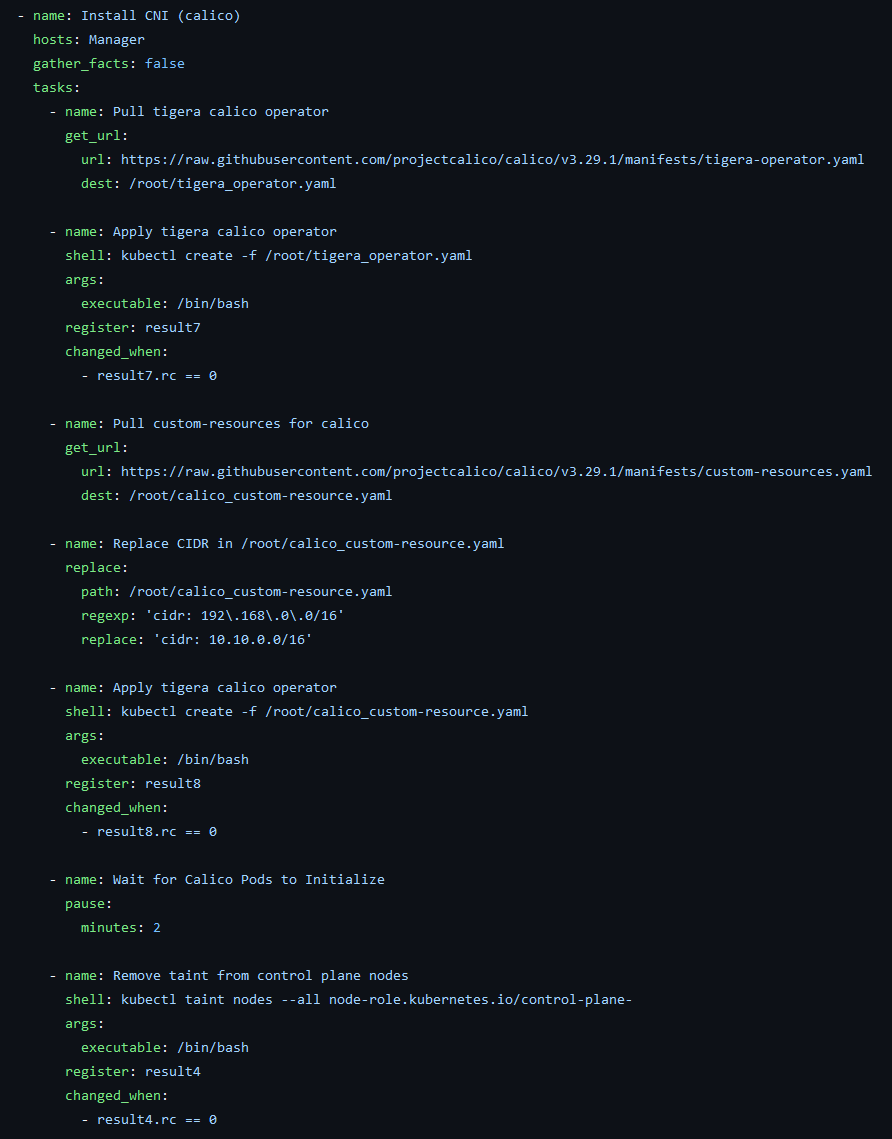
Joining the Worker Nodes
At this point in the script, kubeadm has been successfully deployed, the networking is in place and all there is left to do is joing the worker nodes to the manager. This is a relatively simple process, first you take the output of the kubeadm token create --print-join-command which will print the command that the workers will use to connect back to the manager and then run it on the worker nodes. I had to play around with variables, so that the manager didn’t accidentally try to join itself, so the workaround was to download the output of the above command to a file locally on the ansible-controller and then push it to the worker nodes and have them run the command from the file. 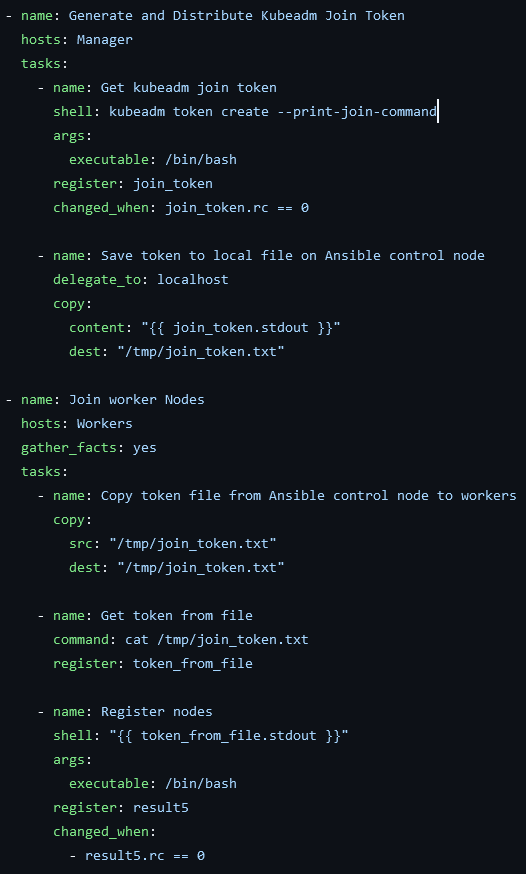
Configuring our Ansible-Controller to manage our K8s cluster
Congrats! At this point, assuming everything went smooth you should now have a fully functioning Kubernetes cluster ready to deploy pods (containers). Before we do some diagnostic checks, lets first configure our ansible-controller to be able to administer the cluster; preventing us from having to ssh into a node. Again here is a quick playbook that will configure the localhost to administer the cluster (assuming you’re logged in as the root user):
1
2
3
4
5
6
7
8
9
10
11
12
13
14
15
16
17
18
19
20
21
22
23
24
25
26
27
28
29
30
31
32
33
34
35
36
37
38
39
40
41
42
43
44
45
46
47
48
---
- hosts: localhost
gather_facts: false
tasks:
- name: Download kubectl binary
get_url:
url: "https://dl.k8s.io/release/v1.27.3/bin/linux/amd64/kubectl"
dest: /usr/local/bin/kubectl
mode: '0755'
- name: Verify kubectl installation
command: kubectl version --client
- name: Create the kubeconfig directory
ansible.builtin.file:
path: /root/.kube
state: directory
mode: 0755
- name: Fetch kubeconfig from control plane node
ansible.builtin.fetch:
src: /etc/kubernetes/admin.conf
dest: /root/.kube/config
flat: yes
delegate_to: mainrhel
become: true
- name: Set KUBECONFIG environment variable
ansible.builtin.lineinfile:
path: /root/.bashrc
line: 'export KUBECONFIG=/root/.kube/config'
create: yes
- name: Add alias for kubectl
ansible.builtin.lineinfile:
path: /root/.bashrc
line: 'alias k=kubectl'
create: yes
- name: Enable tab auto-completion
shell: source <(kubectl completion bash)" >> ~/.bashrc
args:
executable: /bin/bash
- name: Apply tab auto-completion
shell: source ~/.bashrc
args:
executable: /bin/bash
Debugging and Running our first Pod
Now that we have the ability to manage our cluster locally, let’s first ensure that all of our nodes are connected and in the ready status:
1
kubectl get nodes

Everything is looking good, now we can view all of the pods that are currently running on the system to make sure everything is functioning like it should. Remember, these pods are used by Kubernetes to keep Kuberentes (and Calico networking running)
1
kubectl get pods -A
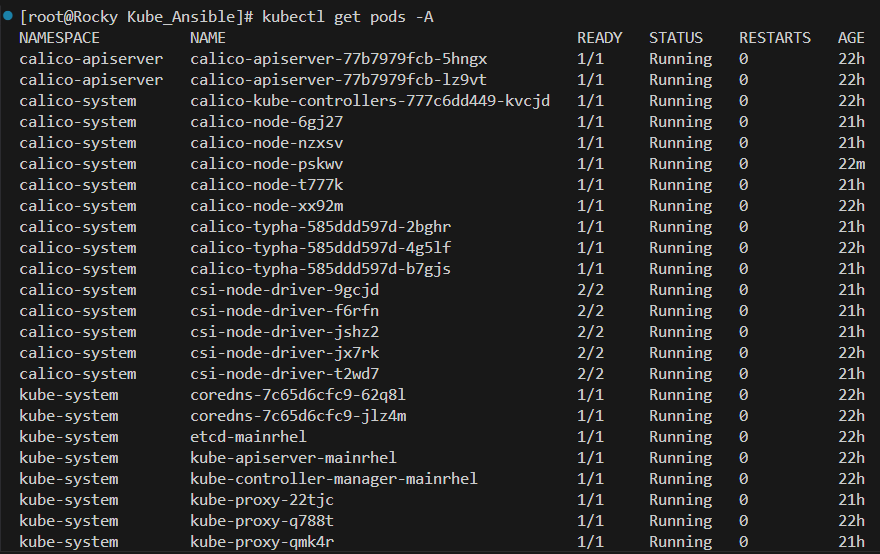
The last demonstration before I post the full playbook is to prove that we can run a container. For this we will just run a basic nginx container and make sure it’s running:
1
2
3
kubectl run nginx --image=nginx
kubectl describe pod nginx

1
2
3
4
5
6
7
8
9
10
11
12
13
14
15
16
17
18
19
20
21
22
23
24
25
26
27
28
29
30
31
32
33
34
35
36
37
38
39
40
41
42
43
44
45
46
47
48
49
50
51
52
53
54
55
56
57
58
59
60
61
62
63
64
65
66
67
68
69
70
71
72
73
74
75
76
77
78
79
80
81
82
83
84
85
86
87
88
89
90
91
92
93
94
95
96
97
98
99
100
101
102
103
104
105
106
107
108
109
110
111
112
113
114
115
116
117
118
119
120
121
122
123
124
125
126
127
128
129
130
131
132
133
134
135
136
137
138
139
140
141
142
143
144
145
146
147
148
149
150
151
152
153
154
155
156
157
158
159
160
161
162
163
164
165
166
167
168
169
170
171
172
173
174
175
176
177
178
179
180
181
182
183
184
185
186
187
188
189
190
191
192
193
194
195
196
197
198
199
200
201
202
203
204
205
206
207
208
209
210
211
212
213
214
215
216
217
218
219
220
221
222
223
224
225
226
227
228
229
230
231
232
233
234
235
236
237
238
239
240
241
242
243
244
245
246
247
248
249
250
251
252
253
254
255
256
257
258
259
260
261
262
263
264
265
266
267
268
269
270
271
272
273
274
275
276
277
278
279
280
281
282
283
284
285
286
287
288
289
290
291
292
293
294
295
296
297
298
299
300
301
302
303
304
305
306
307
308
---
- name: Persistently disable swap
hosts: all
tasks:
- name: Disable swap for current session
command: swapoff -a
register: result
changed_when:
- result.rc == 0
- name: Disable Swap permanently
replace:
path: /etc/fstab
regexp: '^(\s*)([^#\n]+\s+)(\w+\s+)swap(\s+.*)$'
replace: '#\1\2\3swap\4'
backup: yes
- name: Disable SElinux and Add Kube Repo
hosts: all
tasks:
- name: Set SELinux to permissive mode temporarily
command: setenforce 0
register: result2
changed_when:
- result2.rc == 0
- name: Disable SELinux permanently
command: sed -i 's/^SELINUX=enforcing$/SELINUX=permissive/' /etc/selinux/config
register: result3
changed_when:
- result3.rc == 0
- name: Add Kubernetes repository
blockinfile:
path: /etc/yum.repos.d/kubernetes.repo
state: present
create: yes
block: |
[kubernetes]
name=Kubernetes
baseurl=https://pkgs.k8s.io/core:/stable:/v1.31/rpm/
enabled=1
gpgcheck=1
gpgkey=https://pkgs.k8s.io/core:/stable:/v1.31/rpm/repodata/repomd.xml.key
exclude=kubelet kubeadm kubectl cri-tools kubernetes-cni
- name: Download and Configure Containerd
hosts: all
gather_facts: no
tasks:
- name: Download containerd
get_url:
url: https://github.com/containerd/containerd/releases/download/v2.0.0/containerd-2.0.0-linux-amd64.tar.gz
dest: /tmp/containerd-2.0.0-linux-amd64.tar.gz
- name: Extract containerd
unarchive:
src: /tmp/containerd-2.0.0-linux-amd64.tar.gz
dest: /usr/local
remote_src: yes
- name: Create systemd directory
file:
path: /usr/local/lib/systemd/system
state: directory
mode: '0755'
- name: Download containerd.service
get_url:
url: https://raw.githubusercontent.com/containerd/containerd/main/containerd.service
dest: /usr/local/lib/systemd/system/containerd.service
mode: '0644'
- name: Copy runc to /usr/local/sbin
copy:
src: /usr/bin/runc
dest: /usr/local/sbin/runc
mode: '0755'
- name: Reload systemd daemon
systemd:
daemon_reload: yes
- name: Enable and start containerd service
systemd:
name: containerd
state: started
enabled: yes
- name: Create CNI bin directory
file:
path: /opt/cni/bin
state: directory
mode: '0755'
- name: Download CNI plugins
get_url:
url: https://github.com/containernetworking/plugins/releases/download/v1.6.1/cni-plugins-linux-amd64-v1.6.1.tgz
dest: /tmp/cni-plugins-linux-amd64-v1.6.1.tgz
- name: Extract CNI plugins
unarchive:
src: /tmp/cni-plugins-linux-amd64-v1.6.1.tgz
dest: /opt/cni/bin
remote_src: yes
- name: Create containerd config directory
file:
path: /etc/containerd
state: directory
mode: '0755'
- name: Copy containerd config file from controller
copy:
src: kube_config.toml
dest: /etc/containerd/config.toml
mode: '0644'
- name: Restart containerd
ansible.builtin.systemd_service:
name: containerd.service
state: restarted
- name: Install Kubelet/Kubectl/Kubeadm
hosts: all
gather_facts: no
tasks:
- name: Download libnetfilter_cttimeout
get_url:
url: https://mirror.stream.centos.org/9-stream/AppStream/x86_64/os/Packages/libnetfilter_cttimeout-1.0.0-19.el9.x86_64.rpm
dest: /tmp/libnetfilter_cttimeout-1.0.0-19.el9.x86_64.rpm
- name: Download libnetfilter_cthelper
get_url:
url: https://mirror.stream.centos.org/9-stream/AppStream/x86_64/os/Packages/libnetfilter_cthelper-1.0.0-22.el9.x86_64.rpm
dest: /tmp/libnetfilter_cthelper-1.0.0-22.el9.x86_64.rpm
- name: Download libnetfilter_queue
get_url:
url: https://mirror.stream.centos.org/9-stream/AppStream/x86_64/os/Packages/libnetfilter_queue-1.0.5-1.el9.x86_64.rpm
dest: /tmp/libnetfilter_queue-1.0.5-1.el9.x86_64.rpm
- name: Download conntrack-tools
get_url:
url: https://mirror.stream.centos.org/9-stream/AppStream/x86_64/os/Packages/conntrack-tools-1.4.7-4.el9.x86_64.rpm
dest: /tmp/conntrack-tools-1.4.7-4.el9.x86_64.rpm
- name: Import CentOS 9 Stream GPG key
rpm_key:
key: https://www.centos.org/keys/RPM-GPG-KEY-CentOS-Official
state: present
- name: Install conntrack-tools
ansible.builtin.dnf:
name:
- /tmp/libnetfilter_cttimeout-1.0.0-19.el9.x86_64.rpm
- /tmp/libnetfilter_cthelper-1.0.0-22.el9.x86_64.rpm
- /tmp/libnetfilter_queue-1.0.5-1.el9.x86_64.rpm
- /tmp/conntrack-tools-1.4.7-4.el9.x86_64.rpm
state: present
- name: Install kubeadm, kubelet and kubectl
dnf:
name:
- kubeadm
- kubectl
- kubelet
state: present
disable_excludes: kubernetes
- name: Enable and start kubelet service
service:
name: kubelet
state: started
enabled: yes
- name: Initialize kubeadm
hosts: Manager
gather_facts: yes
vars:
pod_cidr: 10.10.0.0/16
tasks:
- name: Check if Kubernetes is already initialized
stat:
path: /etc/kubernetes/admin.conf
register: kubeadm_config
- name: Initialize kubeadm
shell: |
kubeadm init \
--apiserver-advertise-address= \
--apiserver-cert-extra-sans= \
--pod-network-cidr= \
--cri-socket=unix:///var/run/containerd/containerd.sock \
--control-plane-endpoint=
when: not kubeadm_config.stat.exists
args:
executable: /bin/bash
- name: Set up kubeconfig for root
block:
- name: Create .kube directory
ansible.builtin.file:
path: /root/.kube
state: directory
mode: 0755
- name: Copy admin.conf to kubeconfig
ansible.builtin.copy:
src: /etc/kubernetes/admin.conf
dest: /root/.kube/config
remote_src: yes
mode: 0775
- name: Set ownership of kubeconfig
ansible.builtin.file:
path: /root/.kube/config
owner: root
group: root
mode: '0600'
when: not kubeadm_config.stat.exists
- name: Install CNI (calico)
hosts: Manager
gather_facts: false
tasks:
- name: Pull tigera calico operator
get_url:
url: https://raw.githubusercontent.com/projectcalico/calico/v3.29.1/manifests/tigera-operator.yaml
dest: /root/tigera_operator.yaml
- name: Apply tigera calico operator
shell: kubectl create -f /root/tigera_operator.yaml
args:
executable: /bin/bash
register: result7
changed_when:
- result7.rc == 0
- name: Pull custom-resources for calico
get_url:
url: https://raw.githubusercontent.com/projectcalico/calico/v3.29.1/manifests/custom-resources.yaml
dest: /root/calico_custom-resource.yaml
- name: Replace CIDR in /root/calico_custom-resource.yaml
replace:
path: /root/calico_custom-resource.yaml
regexp: 'cidr: 192\.168\.0\.0/16'
replace: 'cidr: 10.10.0.0/16'
- name: Apply tigera calico operator
shell: kubectl create -f /root/calico_custom-resource.yaml
args:
executable: /bin/bash
register: result8
changed_when:
- result8.rc == 0
- name: Wait for Calico Pods to Initialize
pause:
minutes: 2
- name: Remove taint from control plane nodes
shell: kubectl taint nodes --all node-role.kubernetes.io/control-plane-
args:
executable: /bin/bash
register: result4
changed_when:
- result4.rc == 0
- name: Generate and Distribute Kubeadm Join Token
hosts: Manager
tasks:
- name: Get kubeadm join token
shell: kubeadm token create --print-join-command
args:
executable: /bin/bash
register: join_token
changed_when: join_token.rc == 0
- name: Save token to local file on Ansible control node
delegate_to: localhost
copy:
content: ""
dest: "/tmp/join_token.txt"
- name: Join worker Nodes
hosts: Workers
gather_facts: yes
tasks:
- name: Copy token file from Ansible control node to workers
copy:
src: "/tmp/join_token.txt"
dest: "/tmp/join_token.txt"
- name: Get token from file
command: cat /tmp/join_token.txt
register: token_from_file
- name: Register nodes
shell: ""
args:
executable: /bin/bash
register: result5
changed_when:
- result5.rc == 0
#More information To get access to these scripts and more, please feel free to visit my github page: K8s Install
Again, thank so much for taking the time to read and have a great day!
